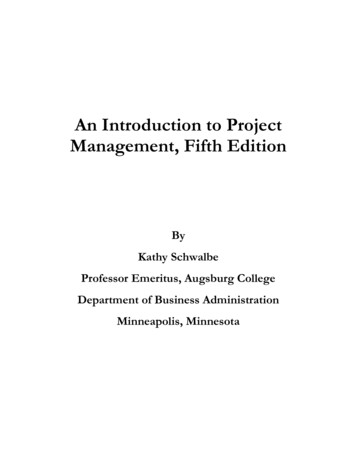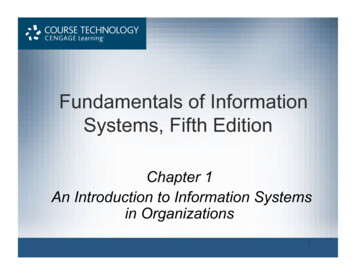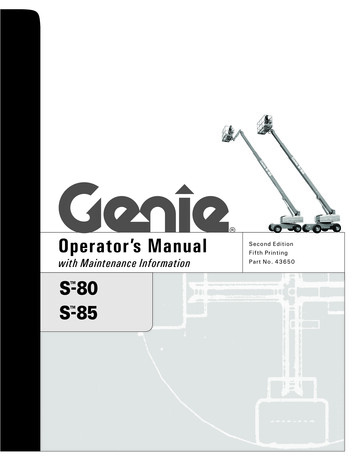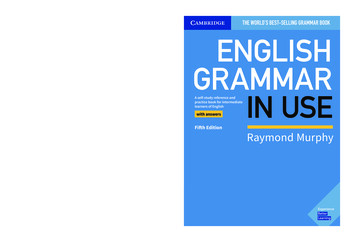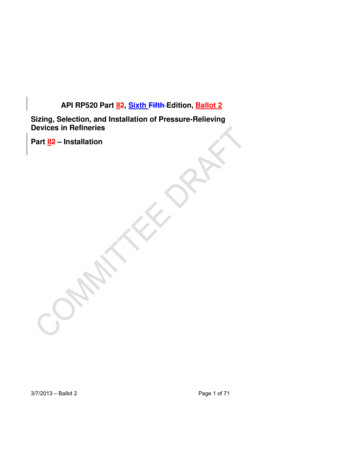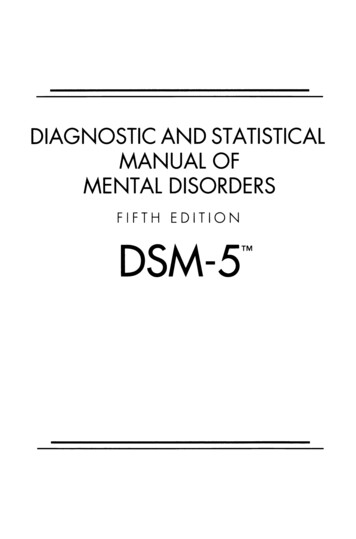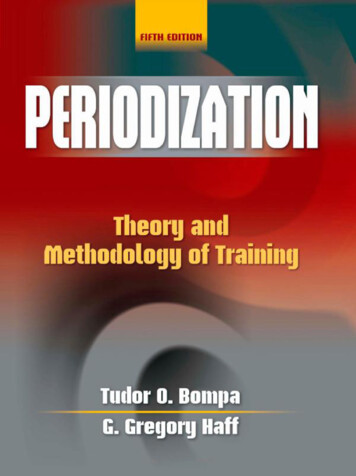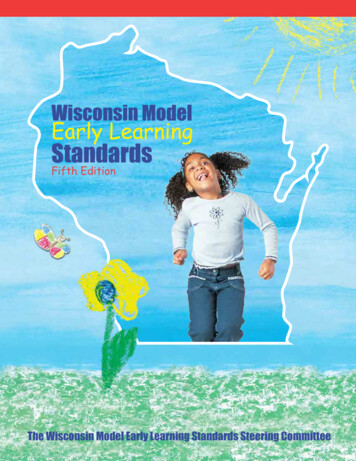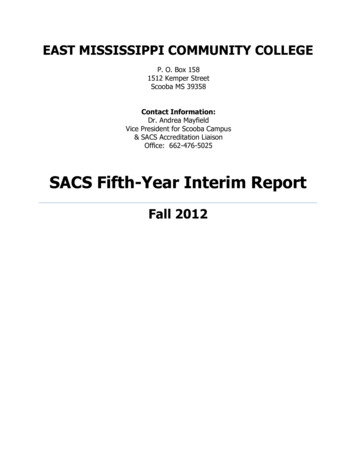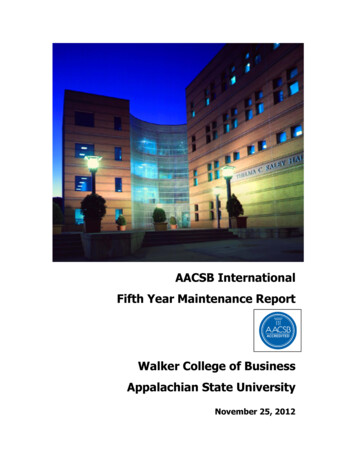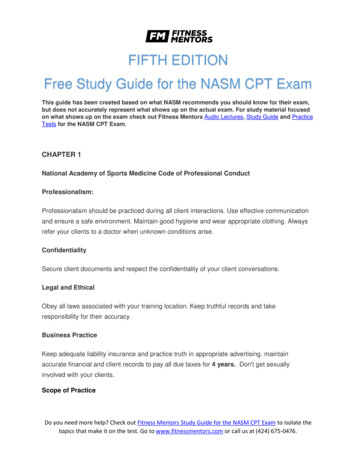
Transcription
FIFTH EDITIONFree Study Guide for the NASM CPT ExamThis guide has been created based on what NASM recommends you should know for their exam,but does not accurately represent what shows up on the actual exam. For study material focusedon what shows up on the exam check out Fitness Mentors Audio Lectures, Study Guide and PracticeTests for the NASM CPT Exam.CHAPTER 1National Academy of Sports Medicine Code of Professional ConductProfessionalism:Professionalism should be practiced during all client interactions. Use effective communicationand ensure a safe environment. Maintain good hygiene and wear appropriate clothing. Alwaysrefer your clients to a doctor when unknown conditions arise.ConfidentialitySecure client documents and respect the confidentiality of your client conversations.Legal and EthicalObey all laws associated with your training location. Keep truthful records and takeresponsibility for their accuracy.Business PracticeKeep adequate liability insurance and practice truth in appropriate advertising. maintainaccurate financial and client records to pay all due taxes for 4 years. Don't get sexuallyinvolved with your clients.Scope of PracticeDo you need more help? Check out Fitness Mentors Study Guide for the NASM CPT Exam to isolate thetopics that make it on the test. Go to www.fitnessmentors.com or call us at (424) 675-0476.
This table shown in the book discusses the guidelines for health and fitnessprofessionals by displaying what a trainer should do if the client's health is of high-risk.What should not be done: Counsel ClientsDiagnose Injuries or ConditionsPhysical therapy or rehabilitationGive detailed diets / meal plansWhat should be done: Coach ClientsIdentify past injuries and limit your exercises for the injuryRecommend client to speak and get medical advice from physicianGeneral Nutrition Knowledge and refer them to a dietitian or nutritionist fordetailed dietsCHAPTER 2NASM does not recommend knowing any of the material from Chapter 2, but does ask about 3questions from the chapter. Check out our Study Guide for the NASM CPT to see what youshould focus on from this chapter.CHAPTER 3Know all definitions throughout the chapter Biomechanics: the study of the action of external and internal forces on the livingbody, especially on the skeletal system.Location Terminology Superior: referring to a point higher or aboveInferior: referring to a point lower or belowProximal: referring to a point closer to the origin of a limbDistal: referring to a point farther from the origin of a limbAnterior (or ventral): referring to a point nearer to the front of the bodyPosterior (or dorsal): referring to a point nearer to the back of the bodyDo you need more help? Check out Fitness Mentors Study Guide for the NASM CPT Exam to isolate thetopics that make it on the test. Go to www.fitnessmentors.com or call us at (424) 675-0476.
Medial: referring to a point nearer to the mid-line of the bodyLateral: referring to a point further from the mid-line of the bodyContralateral: referring to a point on the opposite side of the bodyIpsilateral: referring to a point on the same side of the bodyPlanes of Motion, Axes and Joint Motions Anatomic position:the erect position of the body with the face and gaze directed anteriorly, the upper limbs at the side, and the palms of the hands directed anteriorly. Sagittal plane:a longitudinal plane that divides the body of a bilaterally symmetrical animal into right and left sections.Flexion: the act of bending a limb in the sagittal plane that typically decreases ajoint angle.Extension: the act of extending a limb that typically increases a joint angle.Hyperextension: the extension of a part of the body beyond normal limits. Frontal Plane:a vertical plane at right angles to a sagittal plane, dividing the body intoanterior and posterior portions. Also called frontal plane .Abduction: the act of moving a limb in the frontal plane that typically moves thelimb away from the mid-line of the body.Adduction: the act of moving a limb in the frontal plane that typically moves thelimb back toward the mid-line of the body.TransversePlane: a plane across the body at right angles to the coronal and sagittal plane and perpendicular to the longitudinal axis of a body or object; also, a plane dividing the body into an upper and lower section.Internal Rotation: the act of rotating a limb in the transverse plane toward themid-line of the body; or counter-clockwise when viewed from a superior view.External Rotation: the act of rotating a limb in the transverse plane away fromthe mid-line of the body; or clockwise when viewed from a superior view.Horizontal Abduction: transverse plane movement similar to that of a rear deltoidfly.Horizontal Adduction: transverse plane movement similar to that of a chest fly.Scapular Retraction: the act of sliding the shoulder blades toward the mid-line ofthe body.Scapular Motion: the act of sliding the shoulder blades away from the mid-line ofthe body.Scapular Depression: the act of sliding the shoulder blades inferiorlyScapular Elevation: the act of sliding the shoulder blades superiorlyDo you need more help? Check out Fitness Mentors Study Guide for the NASM CPT Exam to isolate thetopics that make it on the test. Go to www.fitnessmentors.com or call us at (424) 675-0476.
Muscle Actions*Eccentric Eccentric muscle action: when a muscle contraction is accompanied bylengthening muscle tissue.*Concentric Concentric muscle action: when a muscle contraction is accompanied byshortening muscle tissue.*Isometric Isometric muscle action: when a muscle contraction is accompanied by nochange in the length of the muscle tissue.*Isokinetic Isokinetic muscle action: when a muscle maintains a constant speed duringcontraction. Force: movement that results in the slowing down or speeding up of an object. Length-Tension Relationships: optimal length of a muscle results in optimal forceproduction. Force-Couple: a group of muscles that work together to produce force on a joint. Rotary Motion: rotational movement of the joints.Torque: something that produces or tends to produce torsion or rotation; the moment of a force or system of forces tending to cause rotation.Compare to - Three Planes of MotionDo you need more help? Check out Fitness Mentors Study Guide for the NASM CPT Exam to isolate thetopics that make it on the test. Go to www.fitnessmentors.com or call us at (424) 675-0476.
Compare to - Planes, Motions, and AxesFrontal Divides the body into anterior and posterior portionsAnterior-Posterior AxisAbduction and AdductionPlaneJoint MotionFrontalAxis of ell shoulderpress Cable hipabductionAnkle eral FlexionPull up, Cable hipadductionTransverse Divides the body into top and bottom portionsLongitudinal or vertical axisMovements include all rotation, pronation, supination, horizontal abduction andadduction.Do you need more help? Check out Fitness Mentors Study Guide for the NASM CPT Exam to isolate thetopics that make it on the test. Go to www.fitnessmentors.com or call us at (424) 675-0476.
PlaneJoint MotionAxis of RotationInternal RotationExternal RotationExerciseInternal Rotation:Band dductionHorizontalAbductionorVerticalTrunk Rotation:Wood chopHorizontalAdduction: CableChest Fly&HorizontalAbduction: Reardelt fly machinePronationSupinationSagittal Divides the body into left and right halvesCoronal or medial-lateral axisFlexion and extensionPlaneJoint MotionAxis of ral&A.K.A.ExtensionCoronalHamstring curlBarbell curlExtension:Quad Extension,Triceps SkullCrusherCompare to Common force couplesMusclesMovement CreatedDo you need more help? Check out Fitness Mentors Study Guide for the NASM CPT Exam to isolate thetopics that make it on the test. Go to www.fitnessmentors.com or call us at (424) 675-0476.
Shortening of the biceps brachii,brachioradialis, and brachialisElbow flexion in a Bicep CurlShortening of the Psoas majorand minor, rectus femoris andilliacusHip Flexion in a leg liftShortening of the PectoralisMajor, Subscapularis andlatissimus dorsiShoulder internal rotationDifferent muscles pull from different angles but all work to produce the same jointmovement. The biceps, brachioradialis and brachialis muscle all insert into differentlocations, but all work to flex the elbow.Compare to LeversThere are three types of levers.A first-class lever is a stick where the fulcrum is between the weight and the energymoving the weight (your hands, for example). Some common first-class levers are seesaws, crowbars, pliers, scissors (which use two first-class levers together), and ahammer pulling a nail.Do you need more help? Check out Fitness Mentors Study Guide for the NASM CPT Exam to isolate thetopics that make it on the test. Go to www.fitnessmentors.com or call us at (424) 675-0476.
A second-class lever is a stick where the fulcrum is at one end of the stick, you push onthe other end, and the weight is in the middle of the stick. Some common second-classlevers are doors, staplers, wheelbarrows, and can openers.A third-class lever is a stick where the fulcrum is at one end of the stick, you push onthe middle, and the weight is at the other end of the stick. With a third-class lever, youhave to put in more energy than you would just lifting the weight, but you get the weightto move a longer distance in return. Some common examples are a broom, a hoe, afishing rod, a baseball bat, and our own human arms.CHAPTER 4DefinitionsHuman Movement Human Movement System:(Kinetic Chain) is composed of three related systems:Nervous(central and peripheral nerves), Muscular (muscles, tendons, ligamentsand fascia), and Skeletal (joints) systems.Nervous System Nervous System: the system of nerves and nerve centers in an animal or human,including the brain, spinal cord, nerves, and ganglia.Sensory Function: The human body's ability to recognize changes in theenvironment within the body or outside of the body.Integrative Function: the nervous system processes and interprets the sensoryinput and makes decisions about what should be done in each moment.Motor Function: The human body's ability to respond to the information receivedfrom the sensory nervous system.Proprioception: the total nervous system input to the central nervous systemcreating the awareness of the position of one's bodyNeuron: a specialized, impulseconducting cell that is the functional unit of the nervous system, consisting of thecell body and its processes, the axon and dendritesSensory (afferent)neurons: a nerve cell that conducts impulses from a sense organ to the central nervous systemInterneurons: a nerve cell that transmits nerve impulses between neurons.Do you need more help? Check out Fitness Mentors Study Guide for the NASM CPT Exam to isolate thetopics that make it on the test. Go to www.fitnessmentors.com or call us at (424) 675-0476.
Motor (efferent)neurons: a nerve cell that conducts impulses to a muscle, gland, or other effector Central NervousSystem: the part of the nervous system comprising the brain and spinal cord.PeripheralNervousSystem: the portion of the nervous system lying outside the brain and spinal cord that includes the cranial and spinal nervesMechanoreceptors: any of the sense organs that respond to vibration, stretching,pressure, or other mechanical stimuli.Muscle Spindles: aproprioceptor that conveys information on the state of muscle stretch orlength, important in the reflex mechanism that maintains body posture.Golgi TendonOrgans: A proprioceptive sensory nerve ending embedded among the fibers of atendon that is sensitive to muscle tension.Joint Receptors: sensory receptors in joint capsulesthat contribute (along with other sensory inputs) to awareness of joint position and movement (proprioceptive sensation). Skeletal SkeletalSystem: The framework of the body, consisting of bones and other connectivetissues, which protects and supports the body tissues and internal organs.Bones: the hard connective tissue forming the substance of the skeleton, composed of a collagenrich organic matrix impregnated with calcium, phosphate, and other minerals.Joints: the movable or fixed place or part where two bones or elements of a skeleton join.Axial Skeleton: the skeleton of the head and trunk including the skull, vertebralcolumn and rib cage.AppendicularSkeleton: The bones of the limbs, including the bones of the pelvic girdles.Remodeling: mature bone tissue is removed from the skeleton (a processcalled bone resorption) and new bone tissue is formed (a processcalled ossification or new bone formation).Osteoclasts: cells that take away or remove mature bone tissue.Osteoblasts: cells that are responsible for building up new bone tissue.Epiphysis: a part of a bone separated from the main body of the bone by a layerof cartilage and subsequently uniting with the bone through further ossification.Diaphysis: the long, narrow portion of a boneDo you need more help? Check out Fitness Mentors Study Guide for the NASM CPT Exam to isolate thetopics that make it on the test. Go to www.fitnessmentors.com or call us at (424) 675-0476.
Epiphyseal Plate:the disk of cartilage between the shaft and the epiphysis of a long bone during itsgrowth.Periosteum: the normal investment of bone, consisting of a dense, fibrous outer layer, to which muscles attach, and a more delicate, inner layer capable of forming bone.Medullary Cavity: the small cavity in the shaft of a long bone where blood cellformation occurs and marrow is stored.Articular (hyaline) cartilage: a firm, elastic, flexible type of connective tissue thatcovers the end of a bone that makes up a joint. Depressions: a flat area of the bone Processes: a point in the bone used for muscular or ligamentous attachment Ve
05.09.2016 · NASM does not recommend knowing any of the material from Chapter 2, but does ask about 3 questions from the chapter. Check out our . Study Guide for the NASM CPT to see what you should focus on from this chapter. CHAPTER 3 . Know all definitions throughout the chapter Biomechanics: the study of the action of external and internal forces on the living body, especially on File Size: 847KBPage Count: 48
